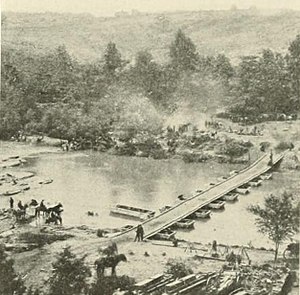Battle of North Anna
| Battle of North Anna | |||||||
|---|---|---|---|---|---|---|---|
| Part of the American Civil War | |||||||
 Pontoon bridge constructed by Union engineers for crossing the North Anna River |
|||||||
|
|||||||
| Belligerents | |||||||
|
|
|
||||||
| Commanders and leaders | |||||||
|
Ulysses S. Grant George G. Meade |
Robert E. Lee | ||||||
| Units involved | |||||||
| Army of Northern Virginia | |||||||
| Strength | |||||||
| 67–100,000 | 50–53,000 | ||||||
| Casualties and losses | |||||||
|
3,986 total (591 killed; 2,734 wounded; 661 captured/missing) |
1,552 (124 killed, 704 wounded, 724 missing/captured) |
||||||
The Battle of North Anna was fought May 23–26, 1864, as part of Union Lt. Gen. Ulysses S. Grant's Overland Campaign against Confederate Gen. Robert E. Lee's Army of Northern Virginia. It consisted of a series of small actions near the North Anna River in central Virginia, rather than a general engagement between the armies. The individual actions are sometimes separately known as: Telegraph Road Bridge and Jericho Mills (for actions on May 23); Ox Ford, Quarles Mill, and Hanover Junction (May 24).
After disengaging from the stalemate at Spotsylvania Court House, Grant moved his army to the southeast, hoping to lure Lee into battle on open ground. He lost the race to Lee's next defensive position south of the North Anna River, but Lee was unsure of Grant's intention and initially prepared no significant defensive works. On May 23, the Union V Corps under Maj. Gen. Gouverneur K. Warren forded the river at Jericho Mills and a Confederate division from the corps of Lt. Gen. A.P. Hill was unable to dislodge its beachhead. The II Corps under Maj. Gen. Winfield S. Hancock stormed a small Confederate force at "Henagan's Redoubt" to seize the Chesterfield Bridge crossing on the Telegraph Road, but did not advance further south across the river.
That night, Lee and his engineers devised a masterful scheme for defensive earthworks in the shape of an inverted "V" that could split the Union army when it advanced and allow the Confederates to use interior lines to attack and defeat one wing, preventing the other wing from reinforcing it in time. Grant initially fell into this trap. As Hancock's men failed to carry the Confederate works on the eastern leg of the V on May 24, a brigade under the drunken Brig. Gen. James H. Ledlie was repulsed from an ill-conceived assault against a strong position at Ox Ford, the apex of the V. Unfortunately for the Confederates, Lee was disabled with an intestinal illness and none of his subordinates were able to execute his planned attack.
...
Wikipedia
